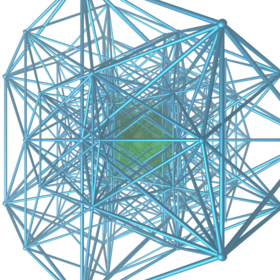| 16-cell honeycomb | |
|---|---|
 Perspective projection: the first layer of adjacent 16-cell facets. | |
| Type | Regular 4-honeycomb Uniform 4-honeycomb |
| Family | Alternated hypercube honeycomb |
| Schläfli symbol | {3,3,4,3} |
| Coxeter diagrams | |
| 4-face type | {3,3,4} |
| Cell type | {3,3} |
| Face type | {3} |
| Edge figure | cube |
| Vertex figure |  24-cell |
| Coxeter group | = [3,3,4,3] |
| Dual | {3,4,3,3} |
| Properties | vertex-transitive, edge-transitive, face-transitive, cell-transitive, 4-face-transitive |
In four-dimensional Euclidean geometry, the 16-cell honeycomb is one of the three regular space-filling tessellations (or honeycombs), represented by Schläfli symbol {3,3,4,3}, and constructed by a 4-dimensional packing of 16-cell facets, three around every face.
Its dual is the 24-cell honeycomb. Its vertex figure is a 24-cell. The vertex arrangement is called the B4, D4, or F4 lattice.[1][2]
